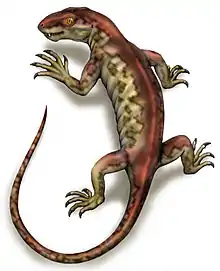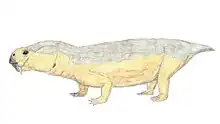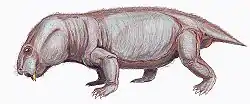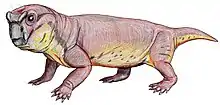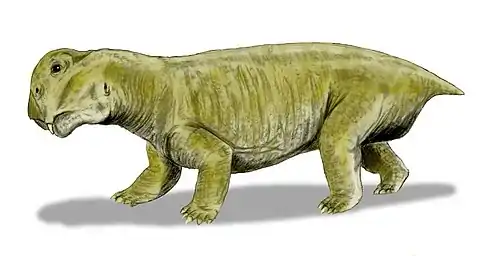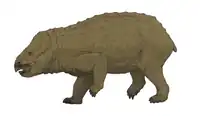Katumbia
Katumbia is a genus of dicynodont from Late Permian (Changhsingian) Kawinga Formation of the Ruhuhu Basin, Tanzania.[1] and possibly the Upper Madumabisa Mudstone Formation of the Luangwa Basin, Zambia.[2] The type species, K. parringtoni, was originally referred to the genus Cryptocynodon, which is now recognized as a junior synonym of Endothiodon.[1]
| Katumbia Temporal range: Late Permian | |
|---|---|
| Scientific classification | |
| Kingdom: | |
| Phylum: | |
| Class: | |
| Order: | |
| Suborder: | |
| Infraorder: | |
| Family: | |
| Genus: | Katumbia Angielczyk, 2007 |
| Species | |
| |
| Synonyms | |
| |
A mandible of Katumbia has been recovered as stomach content of the gorgonopsid ?Sauroctonus parringtoni, indicating that the latter preyed on this dicynodont.[3]
References
- Angielczyk, K.D. (2007). "New specimens of the Tanzanian dicynodont "Cryptocynodon" parringtoni von Huene, 1942 (Therapsida, Anomodontia), with an expanded analysis of Permian dicynodont phylogeny". Journal of Vertebrate Paleontology. 27 (2): 116–131. doi:10.1671/0272-4634(2007)27[116:NSOTTD]2.0.CO;2. S2CID 86308349.
- Angielczyk, Kenneth D.; Steyer, Jean-Sébastien; Sidor, Christian A.; Smith, Roger M. H.; Whatley, Robin L.; Tolan, Stephen (2014). "Permian and Triassic Dicynodont (Therapsida: Anomodontia) Faunas of the Luangwa Basin, Zambia: Taxonomic Update and Implications for Dicynodont Biogeography and Biostratigraphy". Early Evolutionary History of the Synapsida. Vertebrate Paleobiology and Paleoanthropology. pp. 93–138. doi:10.1007/978-94-007-6841-3_7. ISBN 978-94-007-6840-6.
- Maisch, Michael W. (2009). "The small dicynodont Katumbia parringtoni (von Huene, 1942) (Therapsida: Dicynodontia) from the Upper Permian Kawinga Formation of Tanzania as gorgonopsian prey". Palaeodiversity. 2: 279–282.
This article is issued from Wikipedia. The text is licensed under Creative Commons - Attribution - Sharealike. Additional terms may apply for the media files.
